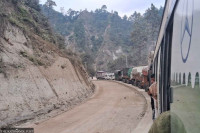Opinion
Genetic analysis can guide Nepal’s development
Routine analysis of scat, tissue, and environmental samples obtained from Nepal’s diverse wildlife can provide information on its occurrence, distribution, diet, diseases, and response to humans.
Brook Milligan
Just as genetic information is used routinely to trace genealogies and solve criminal cases worldwide, it can be used in Nepal to guide the country’s development. Different sectors of development, including tourism, hydropower, transportation, and agriculture, influence each other, and Nepal needs a nuanced understanding of those interactions. Otherwise, development in one area might unintentionally undermine hard-won advances in others.
For example, hydropower and transportation development could make tourism smoother, but it can also degrade the rivers and forests that tourists come to experience. Conversion of forests for agriculture can increase food security, but can also reduce food for predators leading to deadly conflicts with wildlife. Expansion of industrial agriculture may increase short-term food supply but may reduce food security through the loss of locally adapted crops and livestock. These connections and tradeoffs can be revealed via genetic information on wildlife, fish, and plants.
For example, DNA analysis is already being used to characterise and mitigate the impact of hydropower development on Nepal’s fish communities. It is also being used to monitor Nepal’s wildlife, including apex predators such as Bengal tigers in the Terai, common leopards in the mid-hills, and snow leopards in the Himalayas. Genetic characterisation of the breadth of traditional agricultural crops and livestock across Nepal could be an invaluable resource for adapting to climate change. Genetic studies of non-timber forest products could differentiate Nepal’s from those originating elsewhere, thereby creating new market opportunities and enhancing the value chain.
Until recently, such genetic knowledge had been beyond the reach of Nepal’s key institutions. That is slowly shifting as universities, governmental laboratories, and private enterprises purchase advanced tools. Unfortunately, however, demand is insufficient within Nepal to adequately support genetics labs using world-class equipment.
Recent advances have, however, produced a small portable genomic sequencing device, Oxford Nanopore’s MinION, that is appropriate for widespread use within Nepal. The size of a mobile phone, the MinION accepts samples prepared with a simple procedure and streams data directly into a laptop for immediate analysis. The device is relatively inexpensive, does not require a major investment in infrastructure, and is much less financially risky than the large instruments in use elsewhere. These features make the MinION especially appropriate for use in Nepal, but it must still be adapted to the country’s specific needs for data on wildlife, agricultural crops, and diseases.
As a Fulbright Scholar working with Nepali organisations, I have introduced this portable genetics technology to Nepal. We are already improving its fit to Nepal’s unique conditions. With further adaptation, these devices could easily be used to acquire genetic information in ways that would improve development decisions and policies.
Routine analysis of scat, tissue, and environmental samples obtained from Nepal’s diverse wildlife can provide information on its occurrence, distribution, diet, diseases, and response to humans. Analysis of water samples could provide maps of pathogens such as cholera, an invaluable public health resource. And analysis of Nepal’s array of traditional agricultural crops and livestock could improve food security in the face of climate change by identifying locally adapted varieties.
Nepal has the facilities and expertise to use new genetic knowledge productively. Government laboratories in the Nepal Academy of Science and Technology (NAST), the Ministry of Health, and elsewhere already use genetic sequencing and analysis, and non-governmental organisations such as the National Trust for Nature Conservation have established additional laboratories. Both Kathmandu University and Tribhuvan University have biotechnology departments that train Nepali students in genetic analysis. A number of private enterprises such as Centre for Molecular Dynamics Nepal (CMDN) already perform genetic analysis on a fee-for-service basis, especially as part of the growing medical diagnostics industry.
In addition, Nepalis are being trained both domestically and abroad, at the undergraduate, graduate, and post-graduate levels, in the theory and practice of genetic analysis, and many are seeking to establish careers in Nepal.
Nepal’s government should do more to encourage the development and use of genetic technologies. Genetic information can help inform Nepal as it proceeds towards achieving its ambitious development agenda, but only if policies encouraging technical innovation and practical application are implemented. In addition to investing in the facilities and expertise already in Nepal, the government should facilitate strategic scientific collaborations to facilitate rapid growth in the country’s scientific capacity.
To accelerate the use of genetics to inform sound development, Nepal should encourage the exchange of samples, expertise, and technologies, both within the country and internationally. This may require a much more nuanced view of how best to implement international agreements regarding access to genetic resources. Nepal should also provide meaningful incentives for domestic and international scientists and engineers to adapt the MinION to Nepal. Finally, Nepal should encourage a culture of collaboration and information sharing between the government, the private sector, and civil society. Genetic information on Nepal’s wealth of biological resources is potentially valuable for guiding development, but that value will not materialize without active encouragement from the government of Nepal.
These actions are urgent. Development in Nepal is fast-paced, but with little to no environmental science that can help balance the many competing sectors. Prioritising genetics in Nepal is feasible and will contribute a wealth of valuable information to benefit the country and its people.
Milligan is a Professor of Biology at New Mexico State University and a Fulbright Scholar in Nepal.




 6.84°C Kathmandu
6.84°C Kathmandu












